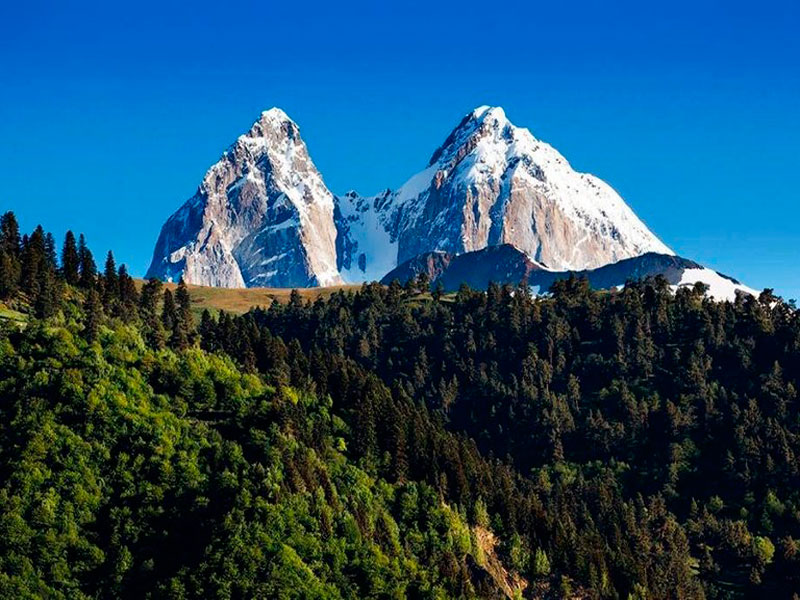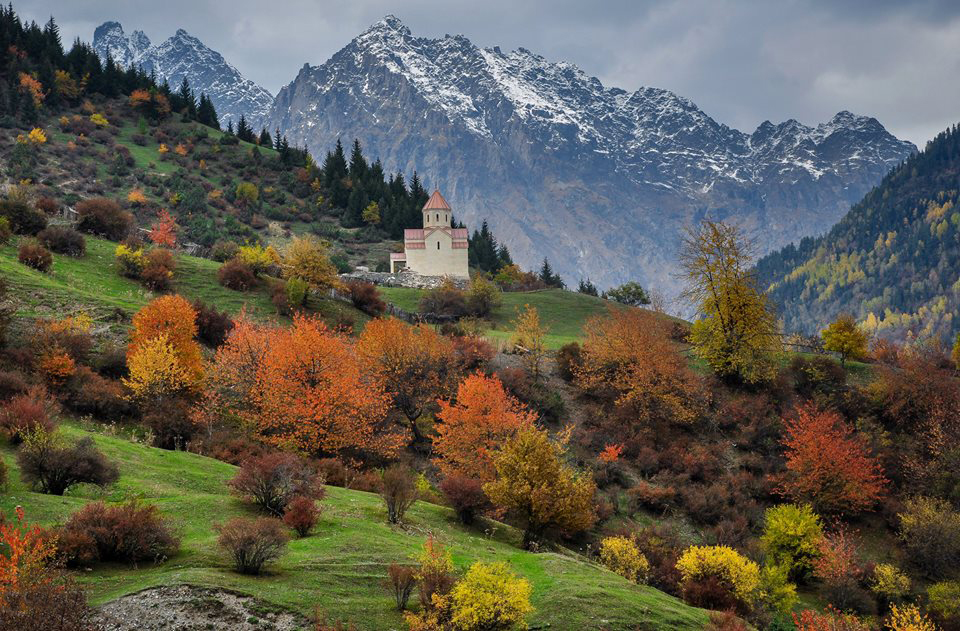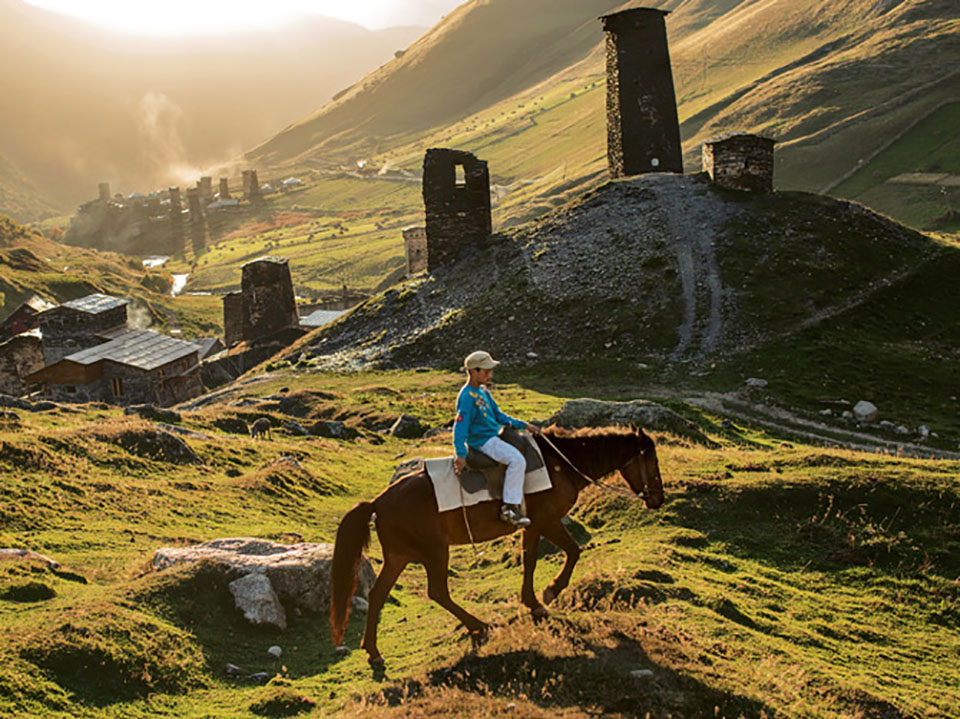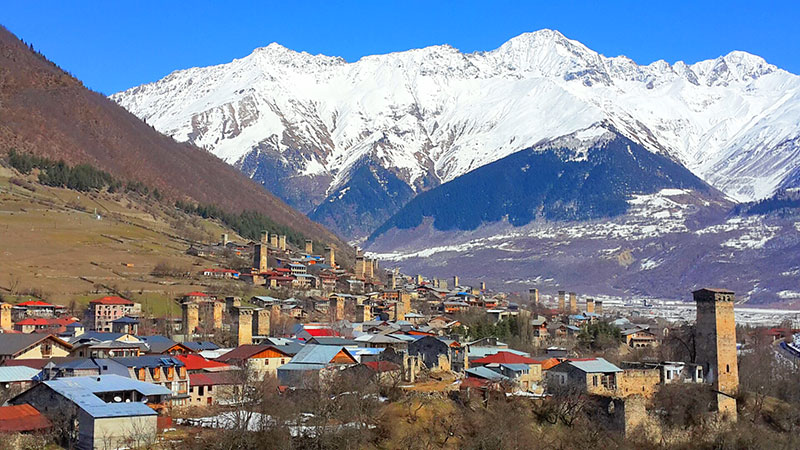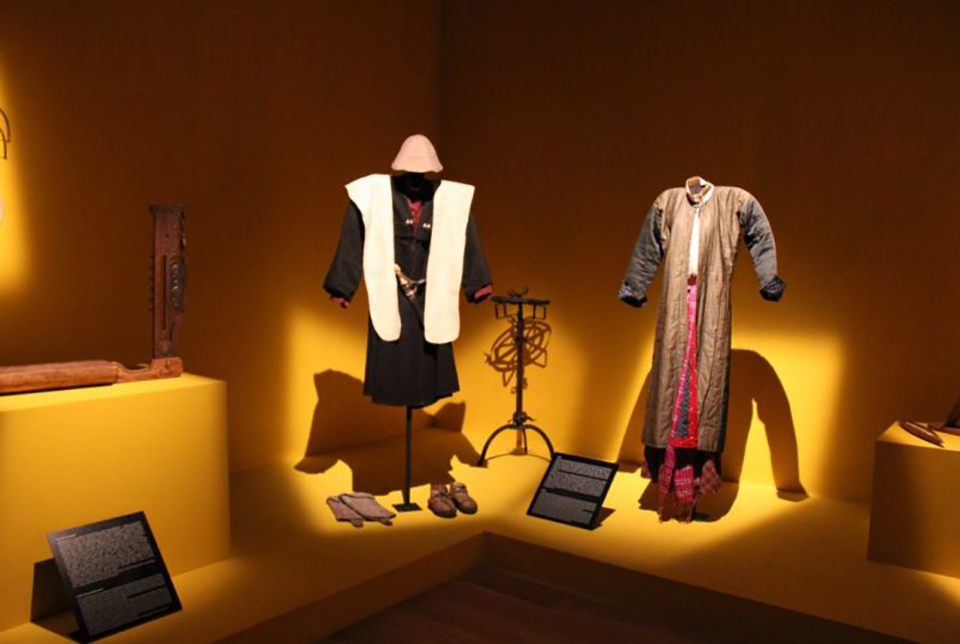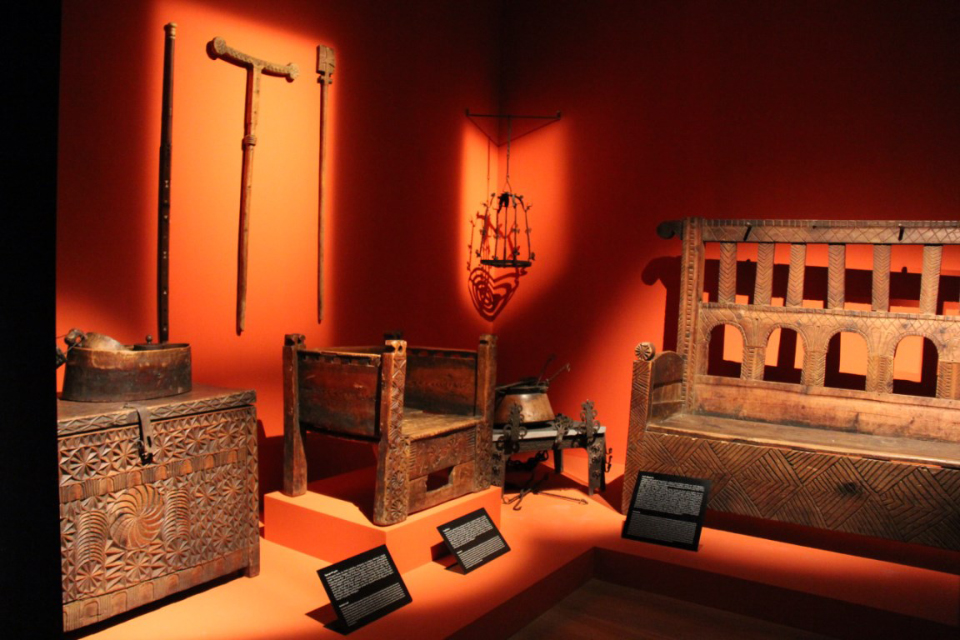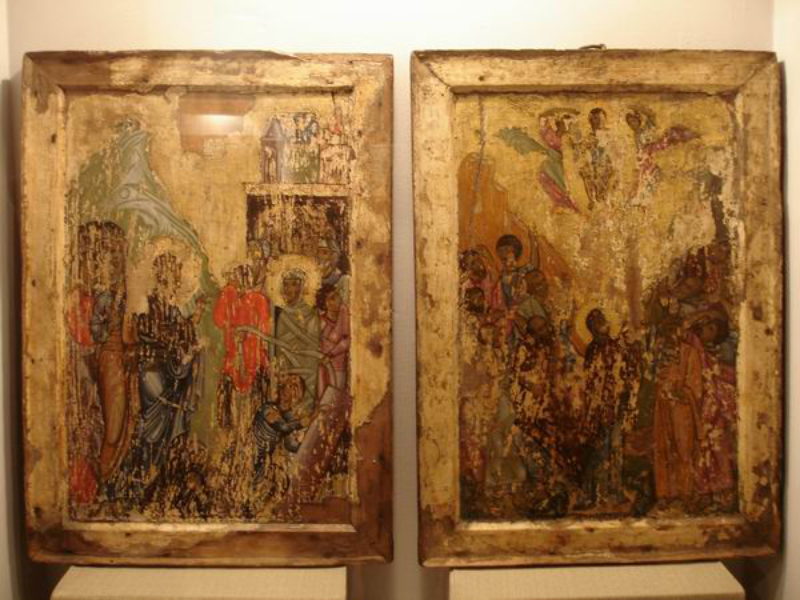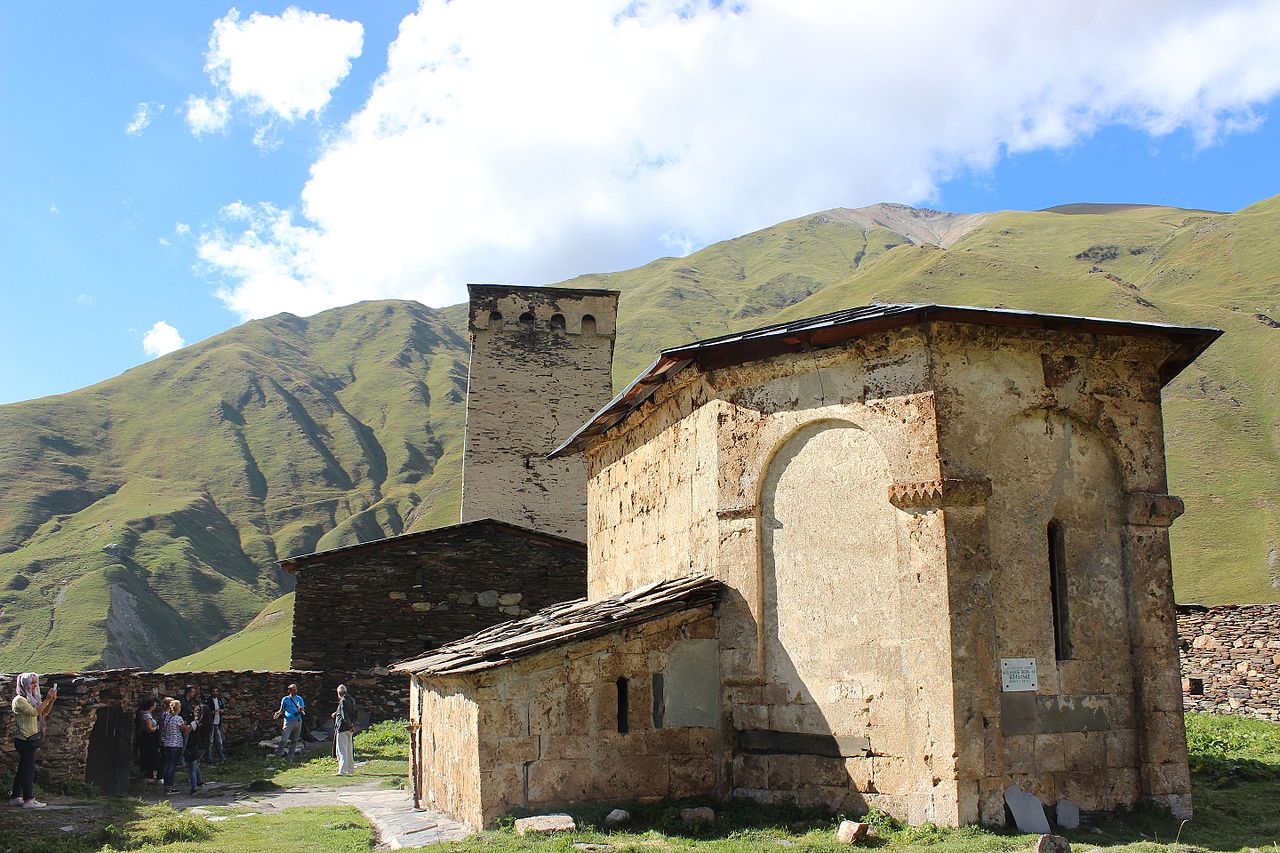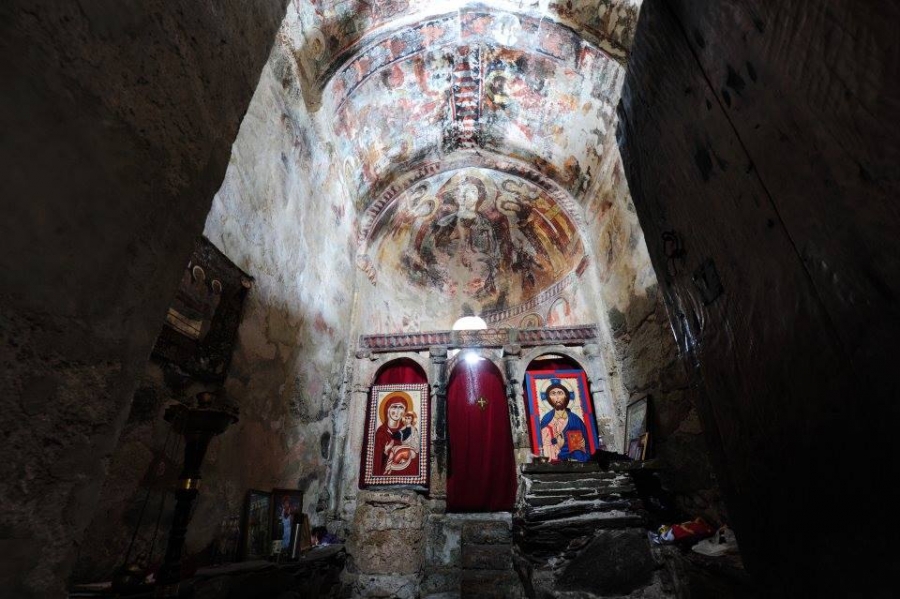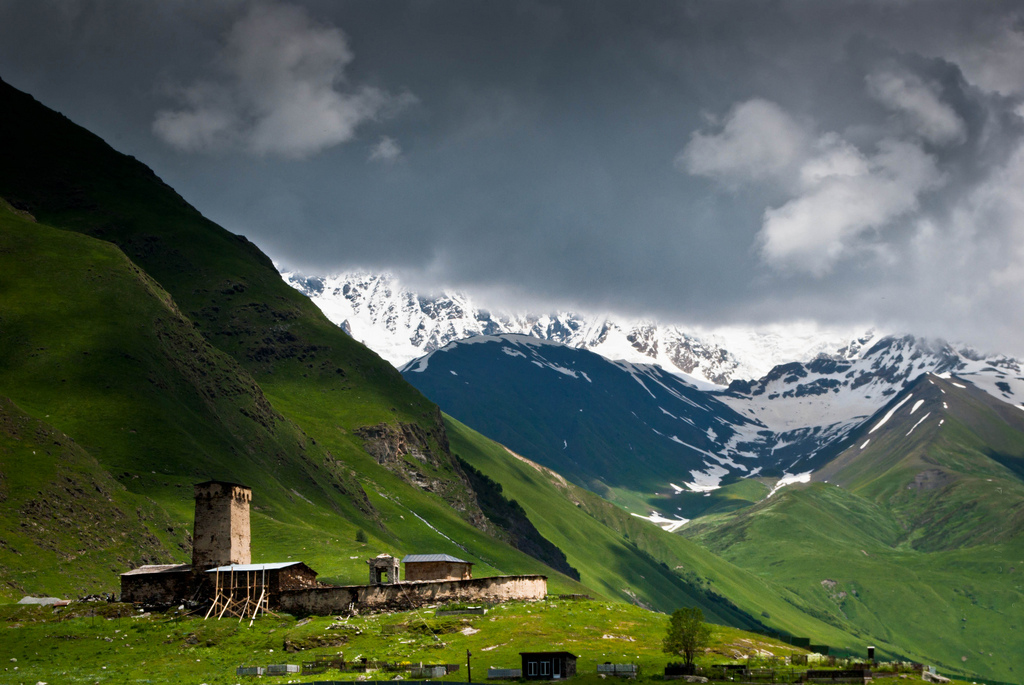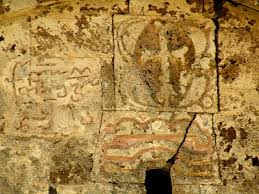

Lamaria (so is called the Virgin by Svans ) was very, very beautiful. She fell in love with Devi ( an evil giant found in old Georgian folktales), and he wanted to marry her. But Lamaria did not agree and refused to marry him. Unable to achieve the desired, Devi decided to subjugate Lamar. He chose the narrowest place in the Inguri gorge, between the villages of Kala and Ushguli, laid out the wall and blocked the way to the Inguri stream. Lamaria is the Svan name of the Blessed Virgin Mary (la is a prefix in Svanian). Lamaria is associated with the female deity, the ancient goddess of cereals and female fertility.
The Inguri is a river in Western Georgia, which rises in Svaneti. Kala - a village in the Upper Svaneti on the banks of the Inguri River. Ushguli is a village in Upper Svaneti on the bank of the Inguri River. The water level increased greatly and reached the village of Ushguli, and the waves blocked the entire valley.
The settlers were very worried. The water took away all the crops. Lamaria was very angry and released her ram against the Devi. Lagurka - from the village of Kala gave her his ram to help. Running from the opposite sides the rams hit and punched through the wall.
For the mountaineers of Eastern Georgia the cult of sacred rams was very important. In the mountain chapels in Mtiuleti (Eastern Georgia) there were sculpture figures of sheep and live sacred rams "expressing" the will of the deities. The Georgian augurs recognized the will according
to the state, movements and color of the wool of the sacred rams. Figures of sheep were put into the sacred vessel full of wine,and the position of the figures let them tell fortunes. This ritual was called "washing the face of God." We can see rams depicted on many archeological monuments in Georgia.
Svans call St. Kiriyak -Lagurka. A monastery and church of this saint stand in the village of Kala and are one of the most glorified shrines of Svaneti. There we can find fragments of paintings dating back to 1183. The month of July is called Kvirikobistve - “the month of Kvirike’ in Georgia.
The Inguri is a river in Western Georgia, which rises in Svaneti. Kala - a village in the Upper Svaneti on the banks of the Inguri River. Ushguli is a village in Upper Svaneti on the bank of the Inguri River. The water level increased greatly and reached the village of Ushguli, and the waves blocked the entire valley.
The settlers were very worried. The water took away all the crops. Lamaria was very angry and released her ram against the Devi. Lagurka - from the village of Kala gave her his ram to help. Running from the opposite sides the rams hit and punched through the wall.
For the mountaineers of Eastern Georgia the cult of sacred rams was very important. In the mountain chapels in Mtiuleti (Eastern Georgia) there were sculpture figures of sheep and live sacred rams "expressing" the will of the deities. The Georgian augurs recognized the will according
to the state, movements and color of the wool of the sacred rams. Figures of sheep were put into the sacred vessel full of wine,and the position of the figures let them tell fortunes. This ritual was called "washing the face of God." We can see rams depicted on many archeological monuments in Georgia.
Svans call St. Kiriyak -Lagurka. A monastery and church of this saint stand in the village of Kala and are one of the most glorified shrines of Svaneti. There we can find fragments of paintings dating back to 1183. The month of July is called Kvirikobistve - “the month of Kvirike’ in Georgia.

Ushba mountain
Shkhara mountain
Lamaria Church
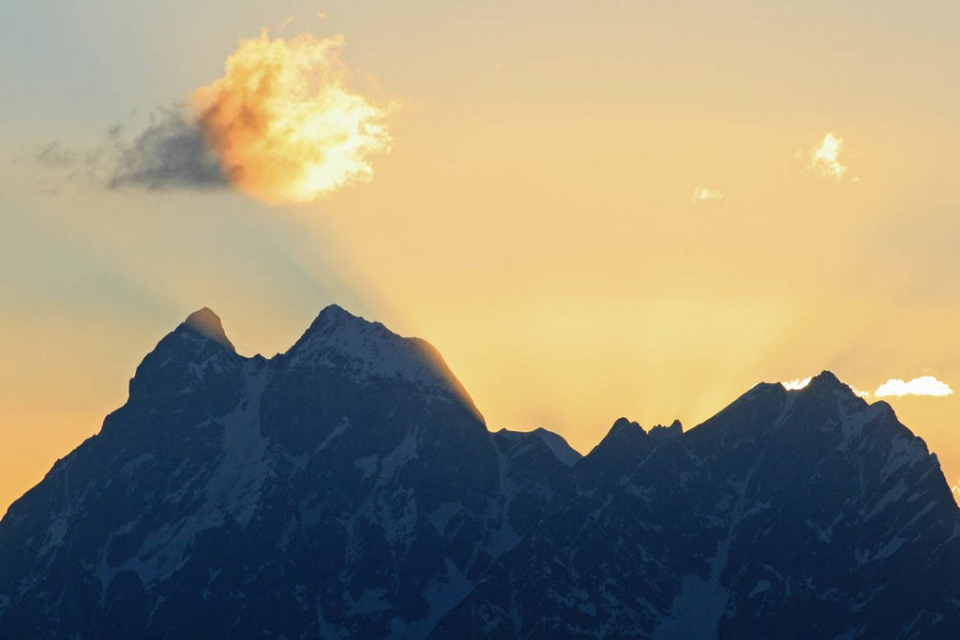
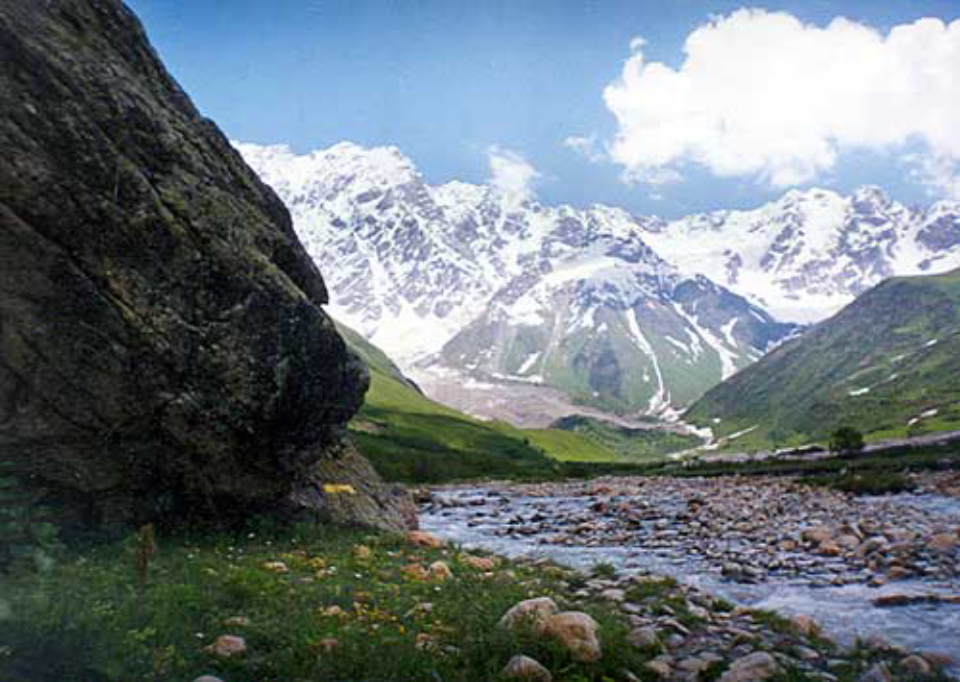
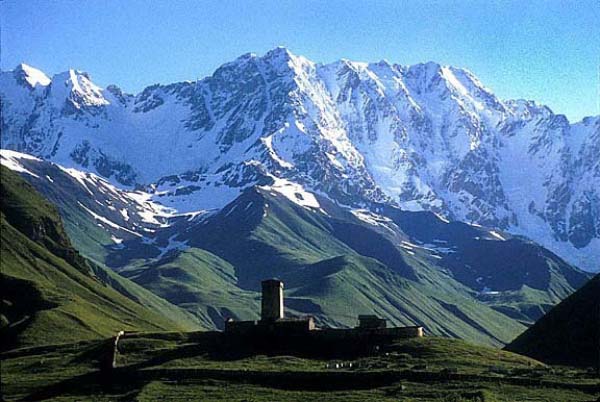
Shkhara - a large peak that is in the north of the eastern hemisphere, to be more precise, it is in the middle
latitudes, the exact coordinates of which belongs to 43 degrees of the northern width and 43.1 degrees
of east longitude. In translation from Balkarian, Ushara (Shkhara) means "not monolithic". Scientists
claim that this name was given to this mountain because the Shkhara massif rises above the entire crest of
the Bezengi wall. Opinions about the name differ - some believe that the title is translated as the ninth
peak, coming from the word "chkhara" meaning number nine. The scientists try to prove their opinion by
saying that the main peak of Shkhara is the ninth if we count from the west. Similarly named are the
glacier that is on the southeast slope and the mountain stream that flows from this glacier.
The geographic peak of Shkhara begins in Eurasia, stretches to the Caucasus Mountains and ends in the
center of the Caucasus. The tops of Shkhara are located in different countries. The South Shkhara
Mountain is in Georgia, but Mount Shkhara is located both in Georgia and in Russia. The Eastern
Shkhara Mountain, like the previous one, is located in both above-mentioned countries.
Rocky massifs are a component of the
Bezengi wall. It should be noted that three large glaciers descend from Mount Shkhara. On the
Russian side - it is the Bashchaouz glacier and on the Georgian side - Chalde and Shkhara. The
height of Shkhara is certainly impressive - the height reaches up to 5200 meters. It was time
when Mount Share was given the first place among the highest mountains of the Caucasus, but
recent studies have shown that this mountain is almost twenty meters lower than Jangitau
mountain. But still Shkhara is considered a real giant of the Caucasus Mountains.
Mount Shkhara was formed from granites and crystalline schist. This mountain is a very popular
place for climbers. Every year the flow of tourist is simply impressive. Soviet people first
visited Mount Shkhara only in 1934. The one who once visited Mount Shkhara will remember
his trip for a long time, filled with pleasant impressions of staying in this part of the planet. The
mountain makes an incredible impression on visitors with the help of its beautiful appearance.
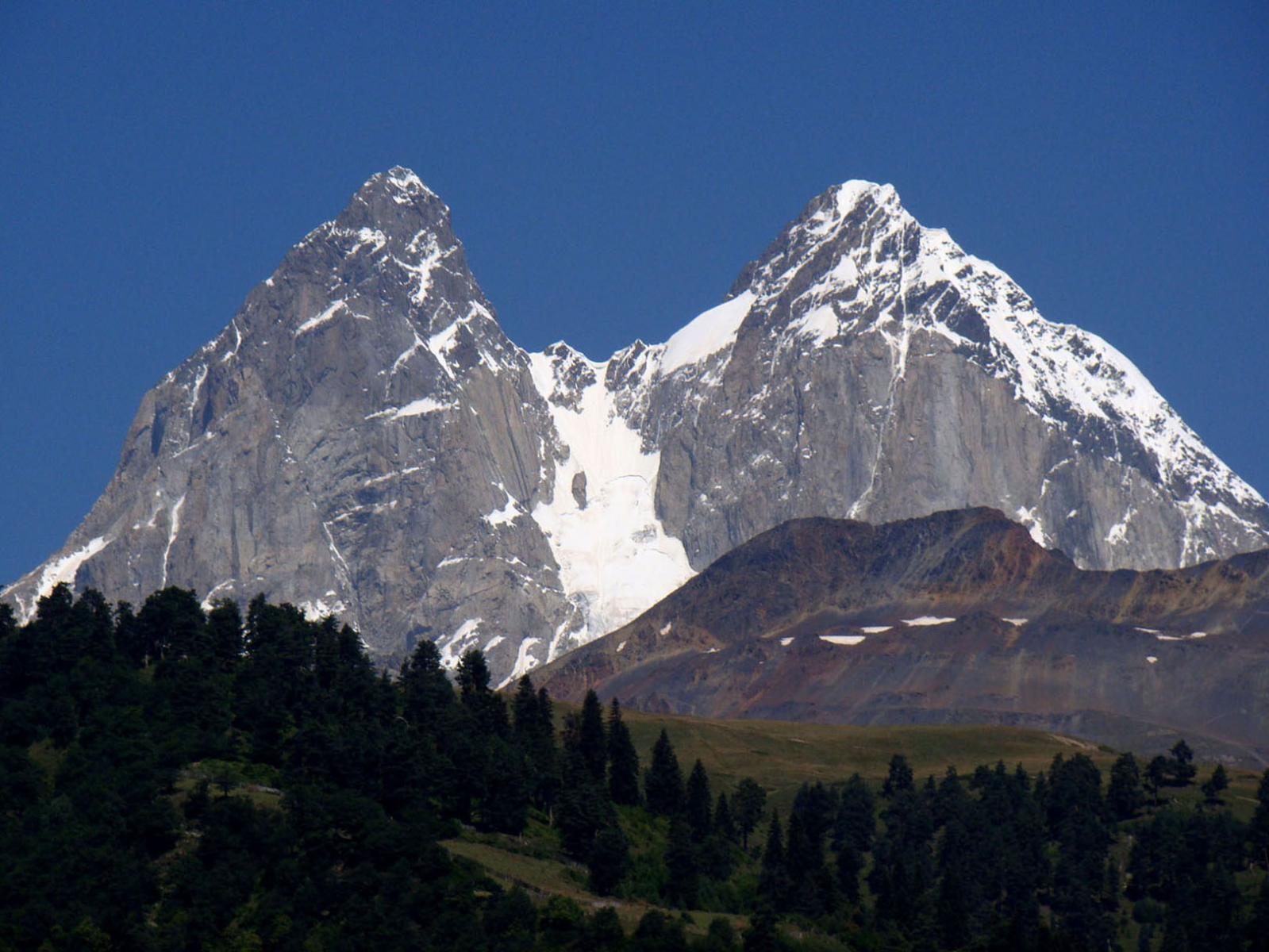
The Eagle's nest - area of thousands of towers.
Svaneti is considered to be one of the first and oldest centers of development of the Georgian state activity and Georgian ethnos. Since ancient times this land has been an inseparable and organic part of Georgia, which is actively involved and participates the life of this country. A lot of interesting facts were written about the life of this wonderful highland region. These facts are documentary descriptions by ancient authors who, at that time, spoke of the might and power of the soldiers, about their quantity and courage. Many historians and academicians attribute the Swans to the tribes of the Penihs or Sanigas, residing on the territory of ancient Colchis.
In this very bizarre country, in the headsources of two rough rivers - Inguri and Tskhenistskali, surrounded by majestic mountains with the lion heart and knightly people, and where there was always a kind and united warrior spirit - a special ethnic group of people was formed and a common Georgian culture developed.
At the same time, Svaneti has always been and remains a special, sublime, unique land. The material civilization, social relations, spiritual and material culture of the native inhabitants of Svaneti have always been an integral part of the overall Georgian culture. In consequence of this, from historical, scientific and ethnographic point of view, Svaneti is considered to be an inexhaustible source and mine of antiquity. This land has always lured and attracted enthusiasts and fans of interesting stories and culture.
There were times in history of Georgia when, during the invasions, the oldest icons, manuscripts, relics, jewelry, valuable documentary sources used to be rescued and taken to Svaneti and hidden there. So, we can say that Svaneti is really a custodian of Georgian national treasure! In Svaneti, the gospel, the so-called Adish quadrilateral, was preserved and saved, and re-written in the 9th century in Shatberdi (Klarjeti). Here, Georgian manuscripts of the 10th century and miraculous icons made by the masters Beka and Beshken Opizari were preserved. Therefore, Svaneti has always attracted attention of researchers of our past - Dimitry Bakradze and Tedo Jordania, Alexander Khakhanashvili and Nico Marr, Ekvtime Takaishvili, Korneli Kekelidze, a famous Russian sociologist Maxim Kovalevsky, Italian and French travelers.
One of the highest mountain regions of Georgia - Svaneti is located on the southern slopes of the Western Caucasus. Zemo Svaneti is located in the gorge of the Inguri River (at an altitude of 1000-2000 meters above sea level), and Kvemo Svaneti is in the gorge of the Tskhenis-Tskali River (at an altitude of 600-1500 meters above sea level). In the south-east Svaneti borders with Racha-Lechkhumi, in the west - with Abkhazia, in the south with Imereti and part of the territory with Samegrelo. In the north the border of Svaneti runs along the Main Caucasian ridge, beyond which there are Karachay and Kabarda.
Ushguli is also a fabulous village located between mountains and the sky, with the community in the extreme east of Svaneti, the highest mountainous settlement in Europe (2,200 m), the area of numerous proudly standing towers. Here is represented a complete typology of the building complexes of Svaneti: economic, defensive, cult, housing. Here you can find ruins of the fortress of the time of Queen Tamar (XII century).
In Svaneti there is a large number of monasteries, churches, castle towers. That’s why it is known as ‘an area of thousands of towers’! As everywhere else, the mountaineers have their own customs and many traditions, religious and Christian, have been preserved in Svaneti, and are revered with great respect. In every corner of small Svaneti there are own ancient ethnic traditions that originated in the time immemorial. On these festive days people gather from all over the region. One of such wonderful old holidays is "Lamarioba". In August in Ushguli, early in the morning, at sunrise, people from all villages of the community of Kala - Ushguli gather in a church at the foot of the beautiful Shkhara Mountain.
This land has survived many foreign invasions and internecine wars, but its pride and dignity has always been preserved, as well as its historical and cultural uniqueness. The so-called Machubas, tower - houses, as a rule, were surrounded by stone walls, and instead of windows they had high crevice-loopholes. In winter even the cattle found shelter in Machubah. It is really a very impressive and interesting structure. (In many families, the Towers were intended for small family chapels where relatives could pray and conduct Christian ceremonies; on the territory of the towers are family cemeteries). Especially at night within the light of street lamps they look especially beautiful. Today these medieval dwellings are used as warehouses - next to the towers, we can already see modern houses. The towers were built from local natural materials - cobblestone, uncouth stones, layered slate slabs - and fastened with lime mortar. Most of the towers are square in cross - section, with a side at the base of 5-6 m, tapering upward. Height - from 10 to 25 m. Their main purpose was to protect people from attacks, whether the internecine wars or blood feuds. Towers have four to five floors each, narrow windows and loopholes. Later, higher and better fortified watchtowers were also built for better protection. It is generally believed that all of them were built in the 12th and 13th centuries, during the golden age of Svaneti - under the rule of Georgian queen Tamara. There have been cases when, during blood feud, families spent years sitting in the towers, storing food, water and ammunition.
Although Free Svaneti was periodically influenced by, various feudal regions of Georgia, local images and features prevail in the basic architecture of all its structures. Churches and monasteries of Svaneti differ both in planning and in the choice of building material. A lot of local churches, built in the X-XII centuries, have one room. Outwardly they represent a very laconic, almost cubic shape. For building the temples, tufa material, never used for residential buildings before, was used. In many churches wall murals of the 10th-12th centuries, (both inside buildings and outside) have been preserved.
Svaneti, by right, is considered a treasure trove of works of art of ancient masters. Over the centuries, in Svaneti villages, ancient manuscript books, precious medieval weapons, remarkable examples of coining and wood carving have been kept and jealously guarded. XI-XIII century - this is the heyday of the coining art, but the ensuing decline was primarily due to historical reasons. As a result of wars, silver and gold rose in value and making icons became a very expensive craft. The engraved icons of that time have hardly been preserved till nowadays - works of art showing high artistic skills.
Svaneti is considered to be one of the first and oldest centers of development of the Georgian state activity and Georgian ethnos. Since ancient times this land has been an inseparable and organic part of Georgia, which is actively involved and participates the life of this country. A lot of interesting facts were written about the life of this wonderful highland region. These facts are documentary descriptions by ancient authors who, at that time, spoke of the might and power of the soldiers, about their quantity and courage. Many historians and academicians attribute the Swans to the tribes of the Penihs or Sanigas, residing on the territory of ancient Colchis.
In this very bizarre country, in the headsources of two rough rivers - Inguri and Tskhenistskali, surrounded by majestic mountains with the lion heart and knightly people, and where there was always a kind and united warrior spirit - a special ethnic group of people was formed and a common Georgian culture developed.
At the same time, Svaneti has always been and remains a special, sublime, unique land. The material civilization, social relations, spiritual and material culture of the native inhabitants of Svaneti have always been an integral part of the overall Georgian culture. In consequence of this, from historical, scientific and ethnographic point of view, Svaneti is considered to be an inexhaustible source and mine of antiquity. This land has always lured and attracted enthusiasts and fans of interesting stories and culture.
There were times in history of Georgia when, during the invasions, the oldest icons, manuscripts, relics, jewelry, valuable documentary sources used to be rescued and taken to Svaneti and hidden there. So, we can say that Svaneti is really a custodian of Georgian national treasure! In Svaneti, the gospel, the so-called Adish quadrilateral, was preserved and saved, and re-written in the 9th century in Shatberdi (Klarjeti). Here, Georgian manuscripts of the 10th century and miraculous icons made by the masters Beka and Beshken Opizari were preserved. Therefore, Svaneti has always attracted attention of researchers of our past - Dimitry Bakradze and Tedo Jordania, Alexander Khakhanashvili and Nico Marr, Ekvtime Takaishvili, Korneli Kekelidze, a famous Russian sociologist Maxim Kovalevsky, Italian and French travelers.
One of the highest mountain regions of Georgia - Svaneti is located on the southern slopes of the Western Caucasus. Zemo Svaneti is located in the gorge of the Inguri River (at an altitude of 1000-2000 meters above sea level), and Kvemo Svaneti is in the gorge of the Tskhenis-Tskali River (at an altitude of 600-1500 meters above sea level). In the south-east Svaneti borders with Racha-Lechkhumi, in the west - with Abkhazia, in the south with Imereti and part of the territory with Samegrelo. In the north the border of Svaneti runs along the Main Caucasian ridge, beyond which there are Karachay and Kabarda.
Ushguli is also a fabulous village located between mountains and the sky, with the community in the extreme east of Svaneti, the highest mountainous settlement in Europe (2,200 m), the area of numerous proudly standing towers. Here is represented a complete typology of the building complexes of Svaneti: economic, defensive, cult, housing. Here you can find ruins of the fortress of the time of Queen Tamar (XII century).
In Svaneti there is a large number of monasteries, churches, castle towers. That’s why it is known as ‘an area of thousands of towers’! As everywhere else, the mountaineers have their own customs and many traditions, religious and Christian, have been preserved in Svaneti, and are revered with great respect. In every corner of small Svaneti there are own ancient ethnic traditions that originated in the time immemorial. On these festive days people gather from all over the region. One of such wonderful old holidays is "Lamarioba". In August in Ushguli, early in the morning, at sunrise, people from all villages of the community of Kala - Ushguli gather in a church at the foot of the beautiful Shkhara Mountain.
This land has survived many foreign invasions and internecine wars, but its pride and dignity has always been preserved, as well as its historical and cultural uniqueness. The so-called Machubas, tower - houses, as a rule, were surrounded by stone walls, and instead of windows they had high crevice-loopholes. In winter even the cattle found shelter in Machubah. It is really a very impressive and interesting structure. (In many families, the Towers were intended for small family chapels where relatives could pray and conduct Christian ceremonies; on the territory of the towers are family cemeteries). Especially at night within the light of street lamps they look especially beautiful. Today these medieval dwellings are used as warehouses - next to the towers, we can already see modern houses. The towers were built from local natural materials - cobblestone, uncouth stones, layered slate slabs - and fastened with lime mortar. Most of the towers are square in cross - section, with a side at the base of 5-6 m, tapering upward. Height - from 10 to 25 m. Their main purpose was to protect people from attacks, whether the internecine wars or blood feuds. Towers have four to five floors each, narrow windows and loopholes. Later, higher and better fortified watchtowers were also built for better protection. It is generally believed that all of them were built in the 12th and 13th centuries, during the golden age of Svaneti - under the rule of Georgian queen Tamara. There have been cases when, during blood feud, families spent years sitting in the towers, storing food, water and ammunition.
Although Free Svaneti was periodically influenced by, various feudal regions of Georgia, local images and features prevail in the basic architecture of all its structures. Churches and monasteries of Svaneti differ both in planning and in the choice of building material. A lot of local churches, built in the X-XII centuries, have one room. Outwardly they represent a very laconic, almost cubic shape. For building the temples, tufa material, never used for residential buildings before, was used. In many churches wall murals of the 10th-12th centuries, (both inside buildings and outside) have been preserved.
Svaneti, by right, is considered a treasure trove of works of art of ancient masters. Over the centuries, in Svaneti villages, ancient manuscript books, precious medieval weapons, remarkable examples of coining and wood carving have been kept and jealously guarded. XI-XIII century - this is the heyday of the coining art, but the ensuing decline was primarily due to historical reasons. As a result of wars, silver and gold rose in value and making icons became a very expensive craft. The engraved icons of that time have hardly been preserved till nowadays - works of art showing high artistic skills.
There lived a brave hunter named Bethkil. Bethkil was young, slender, handsome, and
he was not afraid of anything. Luck always accompanied him, he never returned from
hunting without prey. Neither severe laws and rules of Ushba frightened him. He did not
yield to requests and often went to hunt on its slopes. But the day when the hunter
ascended to the glacier, Dali met him at the summit. She enchanted the young handsome
boy, and he, forgetting from the moment about his house and family, stayed with her to
live on Ushba. For some time they enjoyed their own happiness and love, but one day the
moment came when Betkil looked down, saw the towers of his native village and felt
bored. At night, he secretly left Dali and descended to his home, where the exquisite young
woman of Svanetia was waiting for him, shedding tears. Bethkil had no other way but to
give himself up to a new love and forgot about Dali. At a big celebration the whole crowd
was having fun feasting, singing songs, dancing restlessly. Suddenly people saw jumping
from nowhere - a tour running on the field. The brave hunter could not resist the
temptation, grabbed his bow and chased the pray The tour was deftly jumping along the
wide rocky paths, Batkil was following his footsteps. For some time they enjoyed it.
Without fear of anything brave Betkel continued to pursue the tour, but for an instant, on
the slopes of Ushba the tour disappeared. Betkel remained on steep cliffs, from which
there was no possibility to return. Then he realized who had sent this huge tour - the
goddess Dali. Beneath the rock where Betkel was standing the people gathered. They were
shouting, weeping, stretching out their hands to him but could not help.
Then a brave young man shouted in a loud voice: "May my bride dance!" Surrounded
by people, beloved Betlil fulfilled the last wish of her hero, the dance of Shush-pari.
Again Bethkel shouted: "Can I see how my sister will mourn me!" And his sister came
out, and he watched the dance of mourning and sorrow. "Now I want to see the dance of
the people!" Svans led a round dance with a chorus about the dying Bethkel. And then
the brave handsome man shouted: "Farewell!" - and the echo spread his voice over the
mountains. Bethkil rushed from the cliff and crashed. Since then, the goddess Dali has
never again showed herself to people, and the hunters do not even approach the cliffs of
Ushba, where the goddess of hunting lives. "
Very interesting is the history of conquest of this Mountain: "For a long time, almost
all attempts to climb Ushba ended unsuccessfully”.
In 1906 two Englishmen came to Svaneti and announced their desire to ascend to the
summit of Ushba. They were looking for a guide, but none of the Svans agreed to cross
the border of Dali's domain.
In the years from 1888 to 1936 only five foreign athletes climbed the northern side of
the mountain peak, while the south - ten athlets. About 60 people tried to storm the
summit. Very often attempts to climb Ushba Mountain ends in tragedy.
